Popular categories
Looking for a yarn?

100% Wool
from 2.30 £ /50g
Order DROPS Needles & Hooks
Clicking the ORDER button will redirect you to Wool Warehouse Direct Ltd website
The yarn cost is calculated from the pattern’s smallest size and the yarn’s cheapest product type. Looking for an even better price? You might find it on the DROPS Deals!
Night Shades
Knitted jumper round yoke in DROPS Karisma. Piece is knitted bottom up with Nordic pattern. Size: S - XXXL
DROPS design: Pattern u-874
Yarn group B
----------------------------------------------------------
Size: S - M - L - XL - XXL - XXXL
Materials:
DROPS KARISMA from Garnstudio (belongs to yarn group B)
400-450-500-550-600-650 g colour 21, medium grey
50-100-100-100-100-100 g colour 16, dark grey
50-100-100-100-100-100 g colour 05, black
50-50-50-50-50-50 g colour 01, off white
50-50-50-50-50-50 g colour 72, light pearl grey
----------------------------------------------------------
Color combinations:
A) DROPS Karisma 69, 50, 56, 01, 55.
B) DROPS Karisma 55, 52, 56, 01, 77.
----------------------------------------------------------
ACCESSORIES FOR THE PIECE:
KNITTING TENSION:
21 stitches in width and 28 rows vertically in stocking stitch = 10 x 10 cm.
NEEDLES:
DROPS DOUBLE POINTED NEEDLES AND CIRCULAR NEEDLE SIZE 4 mm, length 40 and 80 cm for the garment in stocking stitch.
DROPS DOUBLE POINTED NEEDLES AND CIRCULAR NEEDLE SIZE 3 mm, length 40 and 80 cm for rib.
Needle size is only a suggestion! If you have too many stitches on 10 cm switch to larger needles. If you have too few stitches on 10 cm switch to smaller needles.
----------------------------------------------------------
-------------------------------------------------------
Alternative Yarn – See how to change yarns here
Yarn Groups A to F – Use the same pattern and change the yarn here
Yarn usage using an alternative yarn – Use our yarn converter here
-------------------------------------------------------
Women Jumpers Nordic Jumpersbottom up colourwork double neck nordic round neck round yoke

100% Wool
from 2.30 £ /50g
Order DROPS Needles & Hooks
Clicking the ORDER button will redirect you to Wool Warehouse Direct Ltd website
The yarn cost is calculated from the pattern’s smallest size and the yarn’s cheapest product type. Looking for an even better price? You might find it on the DROPS Deals!
- English (UK/cm)
- Česky - not translated
- Dansk
- Deutsch
- Eesti keel
- English (US/in)
- Español
- Français
- Íslenska
- Italiano
- Magyar
- Nederlands
- Norsk
- Polski
- Português
- Suomi
- Svenska
- English (UK/cm), Bulgaria
- English (UK/cm), Croatia
- English (UK/cm), Greece
- English (UK/cm), Latvia
- English (UK/cm), Lithuania
- English (UK/cm), Romania
- English (UK/cm), Slovenia
- Česky, Slovakia - not translated
Pattern instructions
----------------------------------------------------------
GARTER STITCH (worked in the round):
1 ridge = 2 rounds. Knit 1 round and purl 1 round.
PATTERN:
Jumper: See diagram A.1. Choose diagram for your size. Work the entire pattern in stocking stitch.
KNITTING TIP:
To avoid the knitting tension to tighten when working pattern with several colours, it is important not to tighten the strands on back side of piece. Switch to a higher needle number when working pattern if the pattern is somewhat tight.
INCREASE TIP (applies to under sleeves):
Work until 1 stitch remains before marker, make 1 yarn over, knit 2 (marker is in the middle of these 2 stitches), make 1 yarn over (= 2 stitches increased). On next round knit yarn overs twisted to avoid holes.
DECREASE/INCREASE TIP (evenly):
To calculate how to decrease/increase evenly, use the total number of stitches on row (e.g. 240 stitches) and divide stitches by number of decreased/increases to be done (e.g. 40) = 6. In this example knit approx. every 5th and 6th stitch together. When increasing make 1 yarn over after every 6th stitch. On next round knit yarn over twisted to avoid holes.
RAGLAN:
Decrease for raglan on each side of marker in every transition between sleeves and body. Begin 2 stitches before marker, knit 2 together, marker is here, slip 1 stitch knitwise, knit 1, pass slipped stitch over stitch worked (= 2 stitches decreased).
ELEVATION IN BACK OF NECK:
For better shape work an elevation in the back of neck with dark grey. Insert 1 marker mid back of neck. Knit until 14-15-16-15-16-18 stitches past marker have been worked, turn, tighten yarn and purl 28-30-32-30-32-36 stitches. Turn and knit 42-45-48-45-48-54 stitches, turn, tighten yarn and purl 56-60-64-60-64-72 stitches back. Turn and knit 70-75-80-75-80-90 stitches, turn, tighten yarn and purl 84-90-96-90-96-108 stitches back. Turn piece, tighten yarn and knit until mid back.
----------------------------------------------------------
START THE PIECE HERE:
----------------------------------------------------------
JUMPER - SHORT OVERVIEW OF THE PIECE:
Work piece in the round on circular needle, bottom up. Work sleeves in the round on double pointed needles.
BODY:
Cast on 240-262-282-306-334-366 stitches on circular needle size 3 mm with medium grey. Work rib (knit 1/purl 1) for 7 cm. Knit 1 round while decreasing 40-44-46-50-56-60 stitches evenly - read DECREASE/INCREASE TIP = 200-218-236-256-278-306 stitches. Switch to circular needle size 4 mm. Continue in stocking stitch. Insert 1 marker at the beginning of round and 1 marker after 100-109-118-128-139-153 stitches (= in the sides). REMEMBER THE KNITTING TENSION! When piece measures 30-31-32-32-34-35 cm, cast off 8-8-10-10-12-14 stitches in each side for armholes (i.e. cast off 4-4-5-5-6-7 stitches on each side of both markers) = 92-101-108-118-127-139 stitches remain on front and back piece. Put piece aside and work the sleeves.
SLEEVE:
Cast on 58-58-64-64-64-72 stitches on double pointed needles size 3 mm with medium grey. Work rib (= knit 1/purl 1) for 5 cm. Knit 1 round while decreasing 10-10-10-10-10-12 stitches evenly = 48-48-54-54-54-60 stitches. Insert 1 marker at beginning of round (= mid under sleeve). Switch to double pointed needles size 4 mm and work in stocking stitch in the round. When piece measures 9-9-9-7-9-8 cm, increase 2 stitches mid under sleeve - read INCREASE TIP. Increase like this every 7th-6th-7th-6th-5th-5th round 12-14-12-14-16-16 times in total = 72-76-78-82-86-92 stitches. When piece measures 42-41-41-39-40-39 cm (NOTE: Shorter measurements in the larger sizes because of wider shoulders), cast off the middle 8-8-10-10-12-14 stitches under sleeve = 64-68-68-72-74-78 stitches remain on needle. Put piece aside and knit another sleeve.
YOKE:
Slip sleeves on to same circular needle as body where armholes were cast off = 312-338-352-380-402-434 stitches on needle. Insert 1 marker in every transition between sleeves and body = 4 markers. Work stocking stitch with medium grey. AT THE SAME TIME on next round decrease for RAGLAN – see explanation above (= 8 stitches decreased). Decrease like this every other round 2-2-3-3-3-3 times in total = 296-322-328-356-378-410 stitches. After last round with decrease knit 1 round while decreasing 24-34-24-32-36-32 stitches evenly = 272-288-304-324-342-378 stitches remain on needle. Then work pattern according to diagram A.1 (choose diagram for correct size = 17-18-19-18-19-21 repetitions on round). Read KNITTING TIP! Continue pattern like this and decrease as shown in diagram. When A.1 has been worked (finish after a round marked with arrow in diagram for correct size), there are 119-126-133-126-133-147 stitches on needle and piece measures approx. 56-58-60-62-64-66 cm from shoulder and down. For better fit work an elevation at the back of neck so that yoke is somewhat higher on back piece. This elevation can be skipped, to make the neck the same at the front and back - read ELEVATION.
NECK EDGE:
Knit 1 round with dark grey while decreasing 25-30-35-26-29-39 stitches evenly = 94-96-98-100-104-108 stitches around the neck edge. Switch to a short circular needle size 3 mm. Work 2 ridges in GARTER STITCH - see explanation above, AT THE SAME TIME on last round increase 22-22-24-26-26-26 stitches evenly = 116-118-122-126-130-134 stitches. Then work rib = knit 1/purl 1. When rib measures 8 cm, work 1 ridge in garter stitch. Loosely cast off - make sure that the cast-off edge is not too tight. Fold neck edge double and sew on the inside, ridge against ridge.
ASSEMBLY:
Sew the openings under the sleeves.
This pattern has been corrected. Click here to see the correction/s.
Correction to BODY: Knit 1 round while decreasing 40-44-46-50-56-60 stitches evenly
Correction: Switch to circular needle size 4 mm. Continue in stocking stitch. Insert 1 marker at the beginning of round and 1 marker after 100-109-118-128-139-153 stitches (= in the sides).
New diagram A.1
Diagram

|
= off white |

|
= light pearl grey |

|
= medium grey |

|
= dark grey |

|
= black |

|
= knit 2 together |
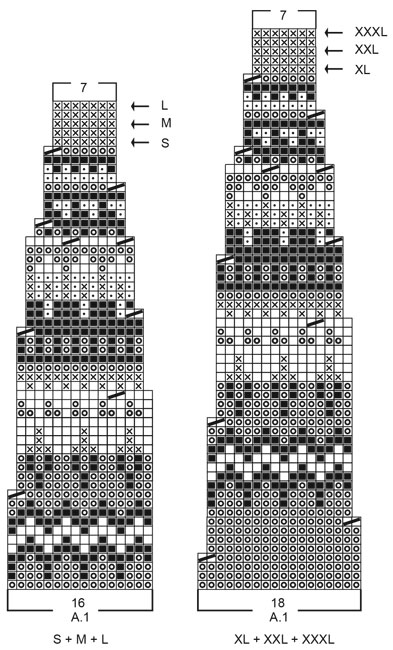
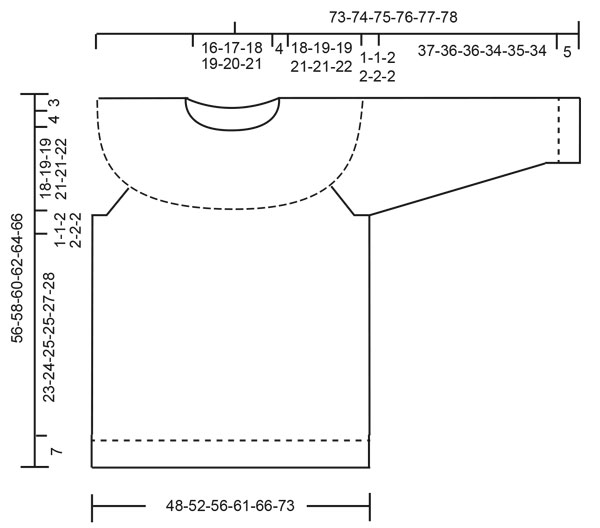
What can you do with our patterns? You can share DROPS patterns online, using the pattern original picture, materials, name and number. But you are NOT ALLOWED to reproduce the complete pattern digitally in any way. Yarn stores are welcome to use the DROPS pattern database to promote the sale of our assortment. You can print out our patterns, make as many copies as you’d like. The only thing we ask is that you don't make any changes / additions to the original printed document. And that the patterns according to the DROPS philosophy are given out to the consumers for free. Editorials that wish to publish our patterns in printed books or magazines can contact us for more information. The sale of garments based on DROPS patterns is permitted as long as they are sold as single items or per order. Further commercial use of the patterns is not permitted. It has to be clearly stated that the garment is made based on a design from DROPS DESIGN. The use of clothing labels of which DROPS DESIGN forms part is conditioned by the inclusion of the following text: “A DROPS DESIGN made by …..”. The use of DROPS photos for marketing purposes/sales is only permitted in connection with the use/sale of DROPS products. The photos may not be cut or edited and the logo should be clearly visible.
We reserve the right to withdraw the permission for use of our patterns at any time, notwithstanding the reason.
Each of our patterns has specific tutorial videos to help you.
These step-by-step tutorials might also help you:
Why is the knitting/crochet tension so important?
Knitting tension is what determines the final measurements of your work, and is usually measured per 10 x 10 cm. It is provided like so: number of stitches in width x number of rows in height - eg: 19 stitches x 26 rows = 10 x 10 cm.
The knitting tension is very individual; some people knit/crochet loosely while others work tightly. You adjust the knitting tension with the needle size, which is why the suggested needle size is only meant as a guide! You need to adjust this (up or down) to ensure that YOUR knitting tension matches the knitting tension provided in the pattern. If you work with a different knitting tension than provided you will have a different yarn consumption, and your work will have different measurements than what the pattern suggests.
The knitting tension also determines which yarns can replace each other. As long as you achieve the same knitting tension you can replace one yarn with another.
See DROPS lesson: How to measure your tension/gauge
See DROPS video: How to make a gauge tension swatch
How do I know how many balls of yarn I need?
The required amount of yarn is provided in grams, eg: 450 g. To calculate how many balls you’ll need you first need to know how many grams are in 1 ball (25g, 50g or 100g). This information is available if you click on the individual yarn quality on our pages. Divide the amount required with the amount of each ball. For example, if each ball is 50g (the most common amount), the calculation will be as follows: 450 / 50 = 9 balls.
Can I use a different yarn than what the pattern suggests?
The important thing when changing from one yarn to another is that the knitting/crochet tension remains the same. This is so that the measurements of the finished piece will be the same as on the sketch provided. It is easier to achieve the same knitting tension using yarns from the same yarn group. It is also possible to work with multiple strands of a thinner yarn to achieve the knitting tension of a thicker one. Please try our yarn converter. We recommend you to always work a test swatch.
Please NOTE: when changing yarn the garment might have a different look and feel to the garment in the photo, due to individual properties and qualities of each yarn.
See DROPS lesson: Can I use a different yarn than the one mentioned in the pattern?
What are the yarn groups?
All our yarns are categorised into yarn groups (from A to F) according to thickness and knitting tension – group A contains the thinnest yarns and group F the thickest. This makes it easier for you to find alternative yarns to our patterns, should you wish to switch yarn. All yarns within the same group have a similar knitting tension and can easily replace each other. However, different yarn qualities have different structures and properties which will give the finished work a unique look and feel.
How do I use the yarn calculator?
At the top of all our patterns you’ll find a link to our yarn calculator, which is a helpful tool should you wish to use a different yarn than suggested. By filling in the yarn quality you wish to replace, the amount (in your size) and number of strands, the calculator will present good alternative yarns with the same knitting tension. Additionally it will tell you how much you’ll require in the new qualities and whether you’ll need to work with multiple strands. Most skeins are 50g (some are 25g or 100g).
If the pattern is worked with multiple colours, every colour will have to be calculated separately. Similarly, if the pattern is worked with several strands of different yarns (for example 1 strand Alpaca and 1 strand Kid-Silk) you will have to find alternatives for each, individually.
Why do you show discontinued yarns in the patterns?
Since different yarns have different qualities and textures we have chosen to keep the original yarn in our patterns. However, you can easily find options among our available qualities by using our yarn calculator, or simply pick a yarn from the same yarn group.
It is possible that some retailers still have discontinued yarns in stock, or that someone has a few skeins at home that they would like to find patterns for.
The yarn calculator will provide both alternative yarn as well as required amount in the new quality.
What size should I knit?
If you think it's hard to decide what size to make, it can be a good idea to measure a garment you own already and like the size of. Then you can pick the size by comparing those measures with the ones available in the pattern's size chart.
You'll find the size chart at the bottom of the pattern.
See DROPS lesson: How to read size chart
Why do I get the wrong knitting tension with the suggested needle size?
The needle size provided in the pattern serves only as a guide, the important thing is to follow the knitting tension. And since knitting tension is very individual, you will have to adjust the needle size to ensure that YOUR tension is the same as in the pattern – maybe you’ll have to adjust 1, or even 2 needle sizes, up or down to achieve the correct tension. For this, we recommend that you work test swatches.
Should you work with a different knitting tension than the one provided, the measurements of the finished garment might deviate from the measurement sketch.
See DROPS lesson: How to measure your tension/gauge
See DROPS video: How to make a tension/gauge swatch
Why is the pattern worked top-down?
Working a garment top-down provides more flexibility and room for personal adjustment. For example it is easier to try the garment on while working, as well as making adjustments to length of yoke and shoulder caps.
The instructions are carefully explaining every step, in the correct order. Diagrams are adjusted to the knitting direction and are worked as usual.
How do I work according to a knitting diagram?
The diagram depicts all rows/rounds, and every stitch seen from the right side. It is read from bottom to top, from right to left. 1 square = 1 stitch.
When working back and forth, every other row is worked from the right side and every other row is worked from the wrong side. When working from the wrong side, the diagram will have to be worked reversed: from left to right, knit stitches are purled, purl stitches are knit etc.
When working in the round every round is worked from the right side and the diagram are worked from right to left on all rounds.
See DROPS lesson: How to read knitting diagrams
How do I work according to a crochet diagram?
The diagram depicts all rows/rounds, and every stitch seen from the right side. It is worked from bottom to top, from right to left.
When working back and forth every other row is worked from the right side: from right to left and every other row is worked from the wrong side: from left to right.
When working in the round, every row in the diagram are worked from the right side, from right to left.
When working a circular diagram you start in the middle and work your way outwards, counter clockwise, row by row.
The rows usually start with a given number of chain stitches (equivalent to the height of the following stitch), this will either be depicted in the diagram or explained in the pattern.
See DROPS lesson: How to read crochet diagrams
How do I work several diagrams simultaneously on the same row/round?
Instructions for working several diagrams after each other on the same row/round, will often be written like so: “work A.1, A.2, A.3 a total of 0-0-2-3-4 times". This means you work A.1 once, then A.2 is worked once, and A.3 is repeated (in width) the number of times provided for your size – in this case like so: S = 0 times, M = 0 times, L=2 times, XL= 3 times and XXL = 4 times.
The diagrams are worked as usual: begin with the first row in A.1, then work the first row in A.2 etc.
See DROPS lesson: How to read knitting diagrams
See DROPS lesson: How to read crochet diagrams
Why are the sleeves shorter in larger sizes?
The total width of the garment (from wrist-to-wrist) will be larger in the larger sizes, despite the actual sleeves being shorter. The larger sizes have longer sleeve caps and wider shoulders, so there will be a good fit in all sizes.
Where on the garment is the length measured?
The measurement sketch/schematic drawing provides information regarding the full length of the garment. If it’s a jumper or a jacket the length is measured from the highest point on the shoulder closest to the neckline, and straight down to the bottom of the garment. It is NOT measured from the tip of shoulder. Similarly, the length of yoke is measured from the highest point on the shoulder and down to where yoke is split into body and sleeves.
On a jacket measures are never taken along bands, unless specifically stated. Always measure inside band stitches when measuring the length.
See DROPS lesson: How to read a schematic drawing
What is a repeat?
Diagrams are often repeated on the round or in height. 1 repeat is the diagram the way it appears in the pattern. If it says to work 5 repeats of A.1 in the round, then you work A.1 a total of 5 times after/next to each other in the round. If it says to work 2 repeats of A.1 vertically/in height you work the entire diagram once, then begin again at the start and work the entire diagram one more time.
Why does the piece start with more chain stitches than it’s worked with?
Chain stitches are slightly narrower than other stitches and to avoid working the cast-on edge too tight, we simply chain more stitches to begin with. The stitch count will be adjusted on the following row to fit the pattern and measurement sketch.
Why increase before the rib edge when the piece is worked top-down?
The rib edge is more elastic and will contract slightly compared to, for example, stocking stitch. By increasing before the rib edge, you avoid a visible difference in width between the rib edge and the rest of the body.
Why increase in the cast-off edge?
It’s very easy to cast off too tightly, and by making yarn overs while casting off (and simultaneously casting these off) you avoid a too tight cast off edge.
See DROPS video: How to bind off with yarn overs (yo)
How do I increase/decrease on every 3rd and 4th row/round alternately?
To achieve an even increase (or decrease) you can increase on, for example: every 3rd and 4th row alternately, like so: work 2 rows and increase on the 3rd row, work 3 rows and increase on the 4th. Repeat this until the increase is complete.
See DROPS lesson: Increase or decrease 1 st on every 3rd and 4th row alternately
How can I work a jacket in the round instead of back and forth?
Should you prefer to work in the round instead of back and forth, you may of course adjust the pattern. You’ll need to add steeks mid-front (usually 5 stitches), and follow the instructions. When you would normally turn and work from the wrong side, simply work across the steek and continue in the round. At the end you’ll cut the piece open, pick up stitches to work bands, and cover the cut edges.
See DROPS video: How to knit steeks and cut open
Can I work a jumper back and forth instead of in the round?
Should you prefer to work back and forth instead of in the round, you may of course adjust the pattern so you work the pieces separately and then assemble them at the end. Divide the stitches for the body in 2, add 1 edge stitch in each side (for sewing) and work the front and back pieces separately.
See DROPS lesson: Can I adapt a pattern for circular needles into straight needles?
Why is the pattern slightly different than what I see in the photo?
Pattern repeats can vary slightly in the different sizes, in order to get the correct proportions. If you’re not working the exact same size as the garment in the photo, yours might deviate slightly. This has been carefully developed and adjusted so that the complete impression of the garment is the same in all sizes.
Make sure to follow instructions and diagrams for your size!
How do I make a women’s size garment into a men’s size one?
If you have found a pattern you like which is available in women’s size it’s not very difficult to convert it to men’s size. The biggest difference will be the length of sleeves and body. Start working on the women size that you think would fit across the chest. The additional length will be worked right before you cast off for the armhole/sleeve cap. If the pattern is worked top-down you can add the length right after the armhole or before the first decrease on sleeve.
Regarding additional yarn amount, this will depend on how much length you add, but it is better with a skein too many than too few.
How do I prevent a hairy garment from shedding?
All yarns will have excess fibres (from production) that might come off as lint or shedding. Brushed yarns (ie hairier yarns) have more of these loose, excess fibres, causing more shedding.
Shedding also depends on what is worn under or over the garment, and whether this pulls at the yarn fibres. It’s therefore not possible to guarantee that there will be no shedding
Below are some tips on how to get the best result when working with hairier yarns:
1. When the garment is finished (before you wash it) shake it vigorously so the looser hairs come off. NOTE: do NOT use a lint roller, brush or any method that pulls at the yarn.
2. Place the garment in a plastic bag and put it in your freezer - the temperature will cause the fibres to become less attached to each other, and excess fibres will come off easier.
3. Leave in the freezer for a few hours before taking it out and shaking it again.
4. Wash the garment according to the instructions on the yarn label.
Why does my garment pill?
Pilling is a natural process that happens to even the most exclusive of fibers. It's a natural sign of wear and tear that is hard to avoid, and that is most visible in high friction areas of your garment like a sweater's arms and cuffs.
You can make your garment look as new by removing the pilling, using a fabric comb or a pill/lint remover.
In the meantime, you can read the questions and answers that others have left to this pattern or join the DROPS Workshop on Facebook to get help from fellow knitters/crocheters!
You might also like...
Night Shades
Night Shades
Night Shades
Night Shades
Night Shades
195-19 Night Shades
Night Shades
Night Shades
Night Shades
Night Shades
Night Shades
Night Shades
Night Shades
195-19 Night Shades
Night Shades
Night Shades
Night Shades |
|||||||||||||||||||
 |
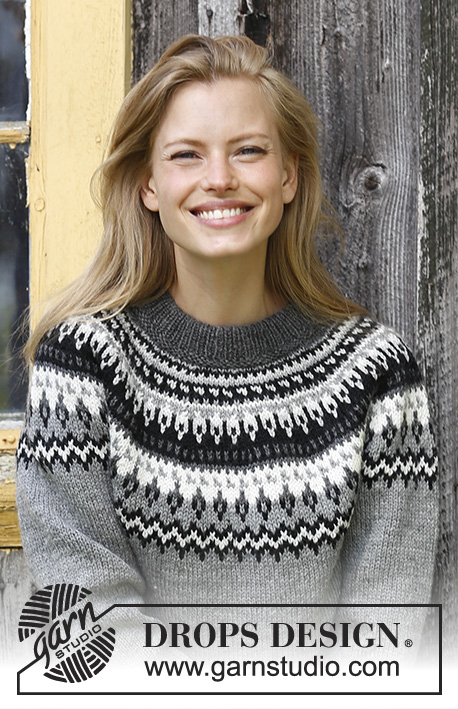 |
||||||||||||||||||
Knitted jumper round yoke in DROPS Karisma. Piece is knitted bottom up with Nordic pattern. Size: S - XXXL
DROPS 195-19 |
|||||||||||||||||||
|
EXPLANATION FOR THE PATTERN: ---------------------------------------------------------- GARTER STITCH (worked in the round): 1 ridge = 2 rounds. Knit 1 round and purl 1 round. PATTERN: Jumper: See diagram A.1. Choose diagram for your size. Work the entire pattern in stocking stitch. KNITTING TIP: To avoid the knitting tension to tighten when working pattern with several colours, it is important not to tighten the strands on back side of piece. Switch to a higher needle number when working pattern if the pattern is somewhat tight. INCREASE TIP (applies to under sleeves): Work until 1 stitch remains before marker, make 1 yarn over, knit 2 (marker is in the middle of these 2 stitches), make 1 yarn over (= 2 stitches increased). On next round knit yarn overs twisted to avoid holes. DECREASE/INCREASE TIP (evenly): To calculate how to decrease/increase evenly, use the total number of stitches on row (e.g. 240 stitches) and divide stitches by number of decreased/increases to be done (e.g. 40) = 6. In this example knit approx. every 5th and 6th stitch together. When increasing make 1 yarn over after every 6th stitch. On next round knit yarn over twisted to avoid holes. RAGLAN: Decrease for raglan on each side of marker in every transition between sleeves and body. Begin 2 stitches before marker, knit 2 together, marker is here, slip 1 stitch knitwise, knit 1, pass slipped stitch over stitch worked (= 2 stitches decreased). ELEVATION IN BACK OF NECK: For better shape work an elevation in the back of neck with dark grey. Insert 1 marker mid back of neck. Knit until 14-15-16-15-16-18 stitches past marker have been worked, turn, tighten yarn and purl 28-30-32-30-32-36 stitches. Turn and knit 42-45-48-45-48-54 stitches, turn, tighten yarn and purl 56-60-64-60-64-72 stitches back. Turn and knit 70-75-80-75-80-90 stitches, turn, tighten yarn and purl 84-90-96-90-96-108 stitches back. Turn piece, tighten yarn and knit until mid back. ---------------------------------------------------------- START THE PIECE HERE: ---------------------------------------------------------- JUMPER - SHORT OVERVIEW OF THE PIECE: Work piece in the round on circular needle, bottom up. Work sleeves in the round on double pointed needles. BODY: Cast on 240-262-282-306-334-366 stitches on circular needle size 3 mm with medium grey. Work rib (knit 1/purl 1) for 7 cm. Knit 1 round while decreasing 40-44-46-50-56-60 stitches evenly - read DECREASE/INCREASE TIP = 200-218-236-256-278-306 stitches. Switch to circular needle size 4 mm. Continue in stocking stitch. Insert 1 marker at the beginning of round and 1 marker after 100-109-118-128-139-153 stitches (= in the sides). REMEMBER THE KNITTING TENSION! When piece measures 30-31-32-32-34-35 cm, cast off 8-8-10-10-12-14 stitches in each side for armholes (i.e. cast off 4-4-5-5-6-7 stitches on each side of both markers) = 92-101-108-118-127-139 stitches remain on front and back piece. Put piece aside and work the sleeves. SLEEVE: Cast on 58-58-64-64-64-72 stitches on double pointed needles size 3 mm with medium grey. Work rib (= knit 1/purl 1) for 5 cm. Knit 1 round while decreasing 10-10-10-10-10-12 stitches evenly = 48-48-54-54-54-60 stitches. Insert 1 marker at beginning of round (= mid under sleeve). Switch to double pointed needles size 4 mm and work in stocking stitch in the round. When piece measures 9-9-9-7-9-8 cm, increase 2 stitches mid under sleeve - read INCREASE TIP. Increase like this every 7th-6th-7th-6th-5th-5th round 12-14-12-14-16-16 times in total = 72-76-78-82-86-92 stitches. When piece measures 42-41-41-39-40-39 cm (NOTE: Shorter measurements in the larger sizes because of wider shoulders), cast off the middle 8-8-10-10-12-14 stitches under sleeve = 64-68-68-72-74-78 stitches remain on needle. Put piece aside and knit another sleeve. YOKE: Slip sleeves on to same circular needle as body where armholes were cast off = 312-338-352-380-402-434 stitches on needle. Insert 1 marker in every transition between sleeves and body = 4 markers. Work stocking stitch with medium grey. AT THE SAME TIME on next round decrease for RAGLAN – see explanation above (= 8 stitches decreased). Decrease like this every other round 2-2-3-3-3-3 times in total = 296-322-328-356-378-410 stitches. After last round with decrease knit 1 round while decreasing 24-34-24-32-36-32 stitches evenly = 272-288-304-324-342-378 stitches remain on needle. Then work pattern according to diagram A.1 (choose diagram for correct size = 17-18-19-18-19-21 repetitions on round). Read KNITTING TIP! Continue pattern like this and decrease as shown in diagram. When A.1 has been worked (finish after a round marked with arrow in diagram for correct size), there are 119-126-133-126-133-147 stitches on needle and piece measures approx. 56-58-60-62-64-66 cm from shoulder and down. For better fit work an elevation at the back of neck so that yoke is somewhat higher on back piece. This elevation can be skipped, to make the neck the same at the front and back - read ELEVATION. NECK EDGE: Knit 1 round with dark grey while decreasing 25-30-35-26-29-39 stitches evenly = 94-96-98-100-104-108 stitches around the neck edge. Switch to a short circular needle size 3 mm. Work 2 ridges in GARTER STITCH - see explanation above, AT THE SAME TIME on last round increase 22-22-24-26-26-26 stitches evenly = 116-118-122-126-130-134 stitches. Then work rib = knit 1/purl 1. When rib measures 8 cm, work 1 ridge in garter stitch. Loosely cast off - make sure that the cast-off edge is not too tight. Fold neck edge double and sew on the inside, ridge against ridge. ASSEMBLY: Sew the openings under the sleeves. |
|||||||||||||||||||
Diagram explanations |
|||||||||||||||||||
|
|||||||||||||||||||

|
|||||||||||||||||||

|
|||||||||||||||||||
|
Have you made this or any other of our designs? Tag your pictures in social media with #dropsdesign so we can see them! Do you need help with this pattern?You'll find tutorial videos, a Comments/Questions area and more by visiting the pattern on garnstudio.com. © 1982-2024 DROPS Design A/S. We reserve all rights. This document, including all its sub-sections, has copyrights. Read more about what you can do with our patterns at the bottom of each pattern on our site. |
|||||||||||||||||||
With over 40 years in knitting and crochet design, DROPS Design offers one of the most extensive collections of free patterns on the internet - translated to 17 languages. As of today we count 304 catalogues and 11422 patterns - 11422 of which are translated into English (UK/cm).
We work hard to bring you the best knitting and crochet have to offer, inspiration and advice as well as great quality yarns at incredible prices! Would you like to use our patterns for other than personal use? You can read what you are allowed to do in the Copyright text at the bottom of all our patterns. Happy crafting!






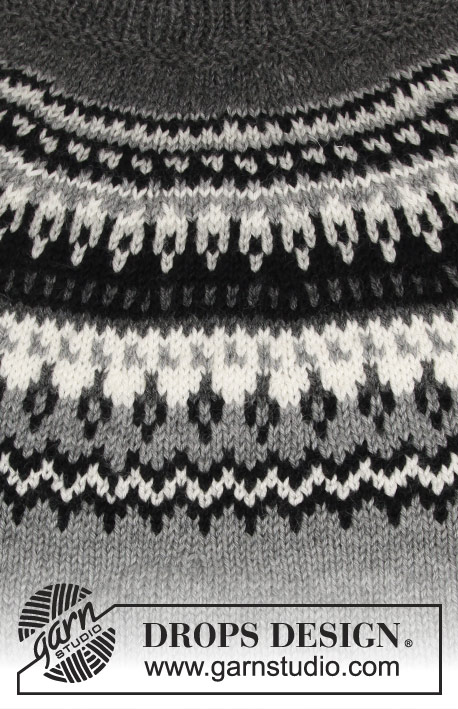
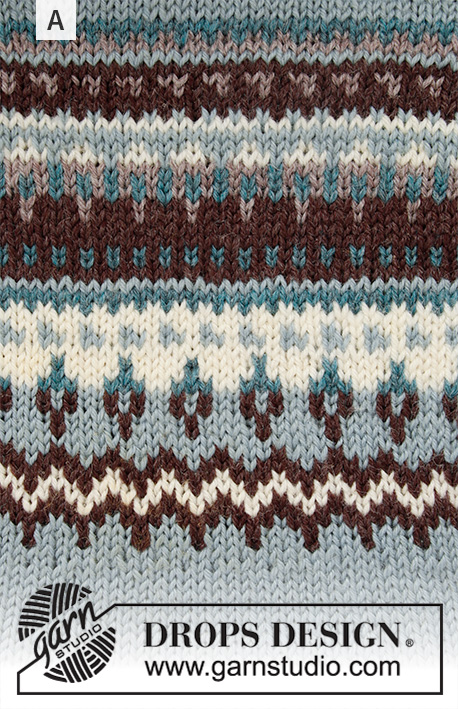
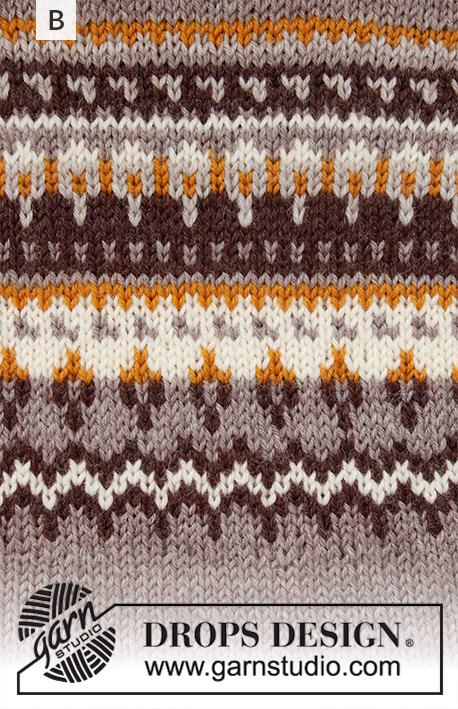

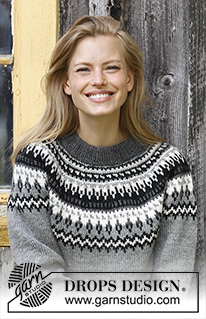


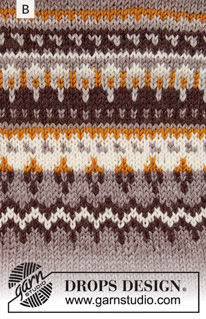






















































Comments / Questions (152)
Hej igen Er det læst korrekt at mønsteret først beynder når ærmerne er sat på bærestykket, synes ikke det tydeligt fremgår af opskrift Hilsen Pie
05.11.2020 - 22:00Bonjour, Je n'ai pas compris comment diminuer les manches dans le modèle 195-19 où placer le marqueur ? (placer un marqueur au début du tour (=milieu sous la manche) augmenter 2 mailles au milieu du tour sous la manche ... les augmentations se font sur un seul côté ou sur les 2 côtés de la manche ? Merci beaucoup Chantal
28.10.2020 - 13:41DROPS Design answered:
Bonjour Chantal, le marqueur est placée au début du tour (= entre la dernière maille montée et la première maille montée); après les côtes, on diminue à intervalles réguliers (= cf cette leçon) puis on augmente comme expliqué sous AUGMENTATIONS (sous les manches) - autrement dit ces augmentations vont se trouver au milieu sous le bras/sous la manche, 1 à la fin du tour et 1 au début du tour. En espérant que ces explications complémentaires à celles d'hier vont vous aider. Bon tricot!
28.10.2020 - 15:36Bonjour, Je ne comprends pas les explications Manches du modèle DROPS 195-19 On tricote sur deux aiguilles n°4 et on place un marqueur en début de tour ? à quoi cela sert-il ? Ensuite on explique qu'il faut diminuer 2 mailles sous la manche ? on augmente 1 maille à chaque début de tour ? il est clair qu'on travaille pas en circulaire n'est-ce pas ? Je suis perdue : faire un jeté = on augmente 2 mailles ? Bref ... merci pour votre aide Chantal
27.10.2020 - 14:02DROPS Design answered:
Bonjour Chantal, les manches se tricotent en rond, d'abord sur les aiguilles doubles pointes, puis sur l'aiguille circulaire (quand on n'a plus suffisamment de place sur les aiguilles doubles pointes). On place un marqueur au début du tour, c'est le changement des tours et en même temps le milieu sous la manche, c'est ainsi de chaque côté de ce marqueur que l'on va d'abord augmenter puis rabattre les mailles pour l'emmanchure. Après les côtes, on va effectivement diminuer pour que la largeur de la manche avec les aiguilles 4 soit la bonne (on a besoin de davantage de mailles avec les aiguilles 3 en côtes qu'avec les 4 en jersey pour la même circonférence). Bon tricot!
27.10.2020 - 16:01Bonjour, Je commence les manches du modèle 195-19 , pouvez-vous m'indiquer avec combien d'aiguilles ? pour 58 mailles deux aiguilles à embouts me semblent très petites ... Merci beaucoup
26.10.2020 - 14:42DROPS Design answered:
Bonjour Chantal, vous pouvez tricoter avec les mailes réparties sur 4 aiguilles (14 m sur 2 aiguilles et 15 m sur 2 aiguilles) et tricoter avec la 5ème aiguille, et changer pour l'aiguille circulaire de 40 cm dès que vous serez un peu à l'étroit sur les double-pointes, mais vous pouvez également tricoter la manche sur une longue circulaire en magic loop. Bon tricot!
27.10.2020 - 11:36Hi, I have casted off the neck very loosely and am now trying to sew the neck edge double. Do you have a tutorial video showing how to do this or could you explain how to do it so that it doesn't twist? Every time I try to sew the casted off edge to the inside, the ribbing of the collar becomes skewed either to the left or right.
25.10.2020 - 22:43DROPS Design answered:
Dear Margot, could this video help you to manage to sew the neck edge? Do not hesitate to contact your DROPS store, they might have more tips for you. Happy knitting!
26.10.2020 - 09:07Ik het lijf en de 2 mouwen af en heb ze nu gezamenlijk op de rondbreipen gezet. Maar nu kan ik de steken van de mouwen nauwelijks breien, want die zijn "in de rondte" gebreid. Hoe los ik dat op?
08.10.2020 - 13:43DROPS Design answered:
Dag Marianne,
Ja, dat is in het begin even een lastig stukje, maar na een aantal naalden gaat het vaak al een stuk beter. Je kunt bij de overgang van het pand naar de mouw of op de lastige stukjes steeds de rondbreinaald eruit trekken volgens de 'magic loop' methode, zoals uitgelegd in deze video
10.10.2020 - 10:33I am knitting this in the large size. I think the length should be adjusted for the body of the sweater as to follow the directions and make the body 12-1/2 inches up to the armhole is way too short. This would only reach the waist. I am making it at least 17", if not 18", and will have to hope I can purchase more wool in the same colour.
05.10.2020 - 21:30Wordt de trui niet te kort met 32 CM voor het lijf , en dan de mouwen ?
04.10.2020 - 21:53DROPS Design answered:
Dag Nancy
Nee hoor, de afmetingen kloppen. Ook de afmetingen in de tekening. Natuurlijk kun je de trui wat langer maken als je dat lievert hebt. Onderaan in de tekening kun je de totale lengte vinden, vanaf de opzetrand tot de hals. Als je de trui langer wilt hebben, kun je er een paar cm bij breien, voordat je afkant voor de armsgaten.
05.10.2020 - 11:07Hi. Are the measurements actual size or is there an easement of 2inches/4cm. Thank you
16.09.2020 - 11:41DROPS Design answered:
Dear Mrs Pickering, all measurements in chart are finished measurements in each size, taken flat, in cm - measure a similar garment you like to compare the measurements and choose the correct size - read more here. Happy knitting!
16.09.2020 - 13:09In dit patroon worden na het breien van de boorden heel veel steken geminderd. Klopt dat wel? Wordt het dan niet een veel te losse boord? ik hoor het heel graag.. want op het plaatje van het patroon is het niet goed tezien hoe de trui dan valt.
05.09.2020 - 17:38DROPS Design answered:
Dag Simone,
Ja hoor dat klopt. Vaak wordt er inderdaad juist gemeerderd, maar in dit patroon is dat niet de bedoeling. Het meerderen wordt gedaan om het samentrekken van de boord a.h.w. te compenseren, waardoor de boordsteek doorloopt ipv samentrekt.
11.09.2020 - 13:41